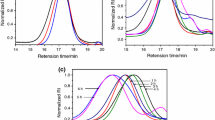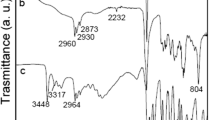Abstract
The study aimed to evaluate the impact of two chain transfer controllers, ethyl 2-(phenylcarbonothiolthio)-2-phenylacetate (EPPA) and 2-(4-methoxyphenylcarbonothiolthio) ethanoic acid (MPEA), from the dithioester family (dithiobenzoates), on the RAFT polymerization of β-myrcene. The initiators employed were azobisisobutyronitrile (AIBN) or dicumylperoxide (DCP), at 65 °C and 90 °C, respectively. The study analyzed the impact of the type of controller, temperature, and initiator/controller ratio on the living nature of β-myrcene polymerization. The results showed that with an increase in the initiator/controller ratio, the rate of polymerization increased, but the obtained molar masses decreased. The MPEA controller showed better performance in controlling the termination and chain transfer reactions, especially when AIBN was used as the initiator. A rise in polymerization temperature led to a loss in the control of polymerization, causing an increase in the degree of polydispersity due to the presence of transfer reactions. The most effective control in the RAFT polymerization of β-myrcene was achieved using MPEA as the controller and AIBN as the initiator, resulting in a poly(β-myrcene) with 87% 1,4-addition according to proton NMR analyses and a polydispersity of 1.27 by gel permeation chromatography (GPC). Finally, the study synthesized a poly(β-myrcene)-b-poly(styrene) block copolymer with low polydispersity (Ð1.1) by sequentially adding styrene to the previously synthesized MPEA-poly(β-myrcene)-based RAFT macrocontroller.
















Similar content being viewed by others
References
Mecking S (2004) Nature or petrochemistry? - Biologically degradable materials. Angewandte Chemie - International Edition 43:1078–1085
Singh P, Verma R (2020) Bioplastics: a green approach toward sustainable environment. In: Singh A, Srivastava S, Rathore D, Pant D (eds) Environmental microbiology and biotechnology, vol 1. Biovalorization of solid wastes and wastewater treatment. Springer, Singapore, pp 35–53
Della Monica F, Kleij AW (2020) From terpenes to sustainable and functional polymers. Polym Chem 11:5109–5127. https://pubs.rsc.org/en/content/articlelanding/2020/py/d0py00817f
Loughmari S, Hafid A, Bouazza A et al (2012) Highly stereoselective coordination polymerization of β-myrcene from a lanthanide-based catalyst: Access to bio-sourced elastomers. J Polym Sci A Polym Chem 50:2898–2905. https://doi.org/10.1002/pola.26069
Díaz de León R, López R, Valencia L et al (2018) Towards Bioelastomers via Coordination Polymerization of Renewable Terpenes Using Neodymium-Based Catalyst Systems. Key Eng Mater 779:115–121. https://doi.org/10.4028/www.scientific.net/KEM.779.115
de León D, Gómez RE, Enríquez-Medrano FJ, Maldonado Textle H et al (2016) Synthesis and characterization of high cis-polymyrcene using neodymium-based catalysts. Can J Chem Eng 94:823–832. https://doi.org/10.1002/cjce.22458
Dev A, Rösler A, Schlaad H (2021) Limonene as a renewable unsaturated hydrocarbon solvent for living anionic polymerization of β-myrcene. Polym Chem 12:3084–3087. https://doi.org/10.1039/D1PY00570G
Lamparelli DH, Kleybolte MM, Winnacker M, Capacchione C (2021) Sustainable myrcene‐based elastomers via a convenient anionic polymerization. Polymers (Basel) 13. https://doi.org/10.3390/polym13050838
Elabed ZO, Kherroub DE, Derdar H, Belbachir M (2021) Novel Cationic Polymerization of β-Myrcene Using a Proton Exchanged Clay (Maghnite-H+). Polym Sci, Ser B 63:480–487. https://doi.org/10.1134/S1560090421050043
Sarkar P, Bhowmick AK (2014) Synthesis, characterization and properties of a bio-based elastomer: Polymyrcene. RSC Adv 4:61343–61354. https://doi.org/10.1039/c4ra09475a
Hilschmann J, Kali G (2015) Bio-based polymyrcene with highly ordered structure via solvent free controlled radical polymerization. Eur Polym J 73:363–373. https://doi.org/10.1016/J.EURPOLYMJ.2015.10.021
Sarkar P, Bhowmick AK (2016) Green Approach toward Sustainable Polymer: Synthesis and Characterization of Poly(myrcene-co-dibutyl itaconate). ACS Sustain Chem Eng 4:2129–2141. https://doi.org/10.1021/acssuschemeng.5b01591
van der Hoff ME, B, (2002) Reactions between Peroxide and Polydiolefins. I&EC Product Research and Development 2:273–278. https://doi.org/10.1021/i360008a006
Métafiot A, Kanawati Y, Gérard JF et al (2017) Synthesis of β-Myrcene-Based Polymers and Styrene Block and Statistical Copolymers by SG1 Nitroxide-Mediated Controlled Radical Polymerization. Macromolecules 50:3101–3120. https://doi.org/10.1021/acs.macromol.6b02675
Pablo-Morales Á, Treviño ME, Saldívar-Guerra E (2022) Toward Bio-Sourced Elastomers with Reactive/Polar Groups. Myrcene – Glycidyl Methacrylate Copolymerization: Reactivity Ratios, Properties, and Preliminary RAFT Emulsion Polymerization. Macromol React Eng 16:2200007. https://doi.org/10.1002/mren.202200007
Bauer N, Brunke J, Kali G (2017) Controlled Radical Polymerization of Myrcene in Bulk: Map** the Effect of Conditions on the System. ACS Sustain Chem Eng 5:10084–10092. https://doi.org/10.1021/acssuschemeng.7b02091
Kalita U, Samanta S, Lal Banerjee S et al (2021) Biobased Thermoplastic Elastomer Based on an SMS Triblock Copolymer Prepared via RAFT Polymerization in Aqueous Medium. Macromolecules 54:1478–1488. https://doi.org/10.1021/acs.macromol.0c02169
Luo W, Yang P, Gan Q et al (2021) Reversible addition–fragmentation chain transfer polymerization of myrcene derivatives: an efficient access to fully bio-sourced functional elastomers with recyclable, shape memory and self-healing properties. Polym Chem 12:3677–3687. https://doi.org/10.1039/D1PY00549A
Hatton FL (2020) Recent advances in RAFT polymerization of monomers derived from renewable resources. Polym Chem 11:220–229
Kutcherlapati SNR, Koyilapu R, Boddu UMR et al (2017) Glycopolymer-Grafted Nanoparticles: Synthesis Using RAFT Polymerization and Binding Study with Lectin. Macromolecules 50:7309–7320. https://doi.org/10.1021/acs.macromol.7b01265
Dhara M, Rudra S, Mukherjee N, Jana T (2021) Hollow polymer nanocapsules with a ferrocenyl copolymer shell. Polym Chem 12:3976–3991. https://doi.org/10.1039/d1py00590a
Rudra S, Dhara M, Chakraborty M, Jana T (2023) Fluorinated Polymer Brush-Grafted Silica Nanoparticles: Robust and Durable Self-Cleaning Coating Materials. ACS Appl Polym Mater 5:7443–7457. https://doi.org/10.1021/acsapm.3c01312
Nothling MD, Fu Q, Reyhani A, et al (2020) Progress and Perspectives Beyond Traditional RAFT Polymerization. Advanced Science 7. https://doi.org/10.1002/advs.202001656
Moad G, Chiefari J, Chong Bill YK et al (2000) Living free radical polymerization with reversible addition – fragmentation chain transfer (the life of RAFT). Polym Int 49:993–1001. https://doi.org/10.1002/1097-0126(200009)49:9%3c993::AID-PI506%3e3.0.CO;2-6
Perrier S (2017) 50th Anniversary Perspective: RAFT Polymerization - A User Guide. Macromolecules 50:7433–7447
Wang AR, Zhu S (2003) Effects of Diffusion-Controlled Radical Reactions on RAFT Polymerization. Macromol Theory Simul 12:196–208. https://doi.org/10.1002/mats.200390015
Hahn C, Wagner M, Muller AH, Frey H (2022) MyrDOL, a Protected Dihydroxyfunctional Diene Monomer Derived from β-Myrcene: Functional Polydienes from Renewable Resources via Anionic Polymerization. Macromolecules 55:4046–4055. https://doi.org/10.1021/acs.macromol.2c00367
Keddie DJ (2014) A guide to the synthesis of block copolymers using reversible-addition fragmentation chain transfer (RAFT) polymerization. Chem Soc Rev 43:496–505
Keddie DJ, Moad G, Rizzardo E, Thang SH (2012) RAFT Agent Design and Synthesis. Macromolecules 45:5321–5342. https://doi.org/10.1021/ma300410v
Moad G, Rizzardo E, Thang SH (2012) Living radical polymerization by the RAFT process a third update. In: Australian Journal of Chemistry. 985–1076
Destarac M (2011) On the Critical Role of RAFT Agent Design in Reversible Addition-Fragmentation Chain Transfer (RAFT) Polymerization. Polym Rev 51:163–187. https://doi.org/10.1080/15583724.2011.568130
Chong BYK, Krstina J, Le TPT et al (2003) Thiocarbonylthio compounds [S=C(Ph)S-R) in free radical polymerization with reversible addition-fragmentation chain transfer (RAFT polymerization). Role of the free-radical leaving group (R). Macromolecules 36:2256–2272. https://doi.org/10.1021/ma020882h
Hinestrosa JP, Uhrig D, Pickel DL et al (2012) Hydrodynamics of polystyrene-polyisoprene miktoarm star copolymers in a selective and a non-selective solvent. Soft Matter 8:10061–10071. https://doi.org/10.1039/c2sm25882j
Allorio S, Pispas S, Siakali-Kioulafa E, Hadjichristidis N (1995) Hydrodynamic behavior of anionically prepared linear polyisoprenes and polystyrenes in carbon tetrachloride. J Polym Sci B Polym Phys 33:2229–2234. https://doi.org/10.1002/polb.1995.090331607
Flory PJ (1948) Effects of Cross-Linking and Branching on the Molecular Constitution of Diene Polymers. Rubber Chem Technol 21:461–470. https://doi.org/10.5254/1.3546927
Arjunan V, Subramanian S, Mohan S (2001) Fourier transform infrared and Raman spectral analysis of trans-1,4-polyisoprene. Spectrochim Acta A Mol Biomol Spectrosc 57:2547–2554. https://doi.org/10.1016/S1386-1425(01)00426-7
Svatoš A, Attygalle BA (1997) Characterization of Vinyl-Substituted, Carbon−Carbon Double Bonds by GC/FT-IR Analysis. Anal Chem 69:1827–1836. https://doi.org/10.1021/ac960890u
Svatoš A, Attygalle AB (1997) Characterization of vinyl-substituted, carbon−carbon double bonds by GC/FT-IR analysis. Anal Chem 69:1827–1836. https://doi.org/10.1021/ac960890u
Tzourtzouklis I, Hahn C, Frey H, Floudas G (2022) Molecular Dynamics and Viscoelastic Properties of the Biobased 1,4-Polymyrcene. Macromolecules 55:8766–8775. https://doi.org/10.1021/acs.macromol.2c01507
Georges S, Bria M, Zinck P, Visseaux M (2014) Polymyrcene microstructure revisited from precise high-field nuclear magnetic resonance analysis. Polymer (Guildf) 55:3869–3878. https://doi.org/10.1016/J.POLYMER.2014.06.021
Author information
Authors and Affiliations
Corresponding author
Ethics declarations
Conflict of interest
The authors declare no conflict of interest.
Additional information
Publisher's Note
Springer Nature remains neutral with regard to jurisdictional claims in published maps and institutional affiliations.
Rights and permissions
Springer Nature or its licensor (e.g. a society or other partner) holds exclusive rights to this article under a publishing agreement with the author(s) or other rightsholder(s); author self-archiving of the accepted manuscript version of this article is solely governed by the terms of such publishing agreement and applicable law.
About this article
Cite this article
Uriel, CA., Cristian, CF., Gumersindo, ML. et al. Study on two different dithiobenzoates effectiveness in bulk RAFT polymerization of β-myrcene. J Polym Res 31, 194 (2024). https://doi.org/10.1007/s10965-024-04045-w
Received:
Accepted:
Published:
DOI: https://doi.org/10.1007/s10965-024-04045-w




